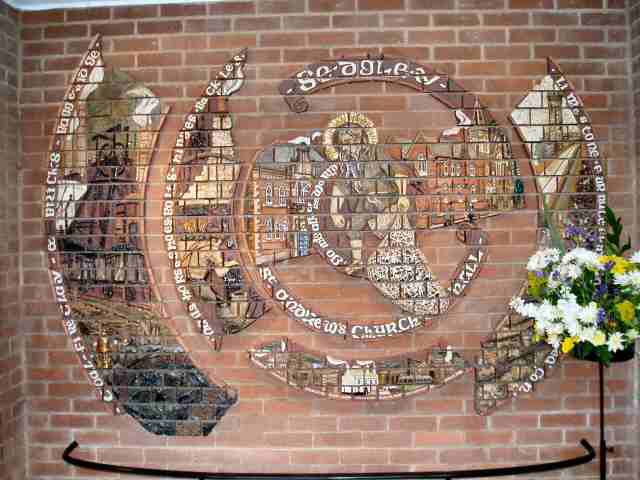The mural provides an arresting focal point to all who enter the doors of St. Andrew's Methodist/United Reformed Church, Sedgley, whatever the reason for their coming. In this piece Trevor Genge describes the meaning behind the mural.

This photograph, taken in March 2004, shows the glazed tile mural as fresh and attractive as at its installation twenty years ago. The Sedgley artist, William Horton Burgess (who also designed and made the mural in Sedgley Local History Museum), makes an annual inspection to keep it in tip top condition.
At the centre Saint Andrew the swarthy fisherman with the physique of a Black Country rolling mill hand, carries his bulging net of gleaming fish. He is so much a workman that only the halo reminds us of his place within the Church Triumphant. He is a symbol that the Church is called to be robustly missionary in character.
Immediately behind Saint Andrew, to the left, is the High Street Methodist Church building, and to the right the Bilston Street Congregational Church in its heyday with the Darbey Schools prominent. [It was the Darbey School that was demolished to make way for these new buildings in which you stand.] The smoking chimneys, a feature of the mural, remind us that the two churches were active at the date of their union and the joining was from strength and not weakness.
The Inner circle around Saint Andrew contains to the left the great missionary challenge of Jesus to his disciples to "GO INTO ALL THE WORLD" as recorded by Saint Mark Chapter 16 verse 15. On the more muted right-hand side are two very important symbols of local significance. The hand-made nails remind us that the origins of the Congregational church owed much to the work and vision of Stephen Wilkes, Nail maker, who first provided a building in Castle Street. The Coffee Mill represents John Hall, Coffee Mill maker of Bilston Street, who used his own home for the first Wesleyan Methodist meetings in Sedgley.
The intermediate segment to the left of the inner circle portrays one of the many little workshops that were so typical of the area. The "Cottage hearth Industry", particularly of nail making, was at the heart of the local economy. This hearth and hammer shows the environment in which so many lives were forged. There was a diversity in the metal trade too, and other manufactured ironware is listed by name.
The outer segment left shows Baggeridge with its colliery and brickworks; a later stage of the industrial revolution, The whole of the Black Country owed its industrial growth to the riches of its raw materials, coal, fireclay, and ironstone, all being found locally. Here the gleam of the miner's lamp outshines the little Coltsfoot that grows tenaciously on the spoil heap. The Artist's name and the Mural's dedication lie unobtrusively amongst the coal.
The outer segment right features Sedgley Beacon Hill and its tower, synonymous with the area for many years. Early man found this ridge his safest passage and ever since it has been the backbone of the Ancient Manor. The Beacon slopes still contain a varied flora. The observant may find wild rose, tufted vetch, dandelion, and ox eye daisy, thistle and hawthorn, common enough, but the modest scabia may still be found. The Outer motif shows that the limestone served a dual purpose to our community at the edge of the industrial Midlands. Used as a flux for iron smelting it was also burned in kilns to provide lime for the farmers' fields. The Ridge itself is evidence of life earlier than man and the fossils of life 450 million years ago can be seen locked within its strata. Most geologically famous is the Trilobite identified even by the expert as "the Dudley Bug".
The Lower section contains a selection of Sedgley landmarks. From left to right they are: St. Chad's R.C. Church tower, The Grand Junction Inn, The Parish Church of All Saints, the Gateway to the old cemetery in Vicar Street [now a garden of rest and once part of .the village green], The Earl of Dudley's Court House [now the Court House Inn], the Clifton Cinema, the Bull Ring traffic island, a Wolverhampton Corporation Trolley Bus in green and yellow livery, the Brick Street Nail shop. In the background another view of Beacon Hill from which messages in fire have been transmitted over the centuries.
The Mural reminds us of our
place in history, and in the present; our debt to the past, and our challenge
to serve the whole community of Sedgley in this present age.
